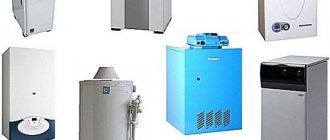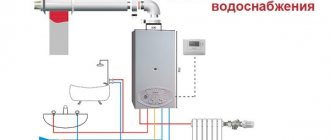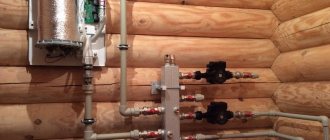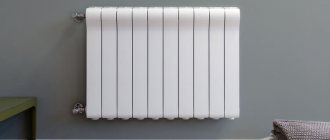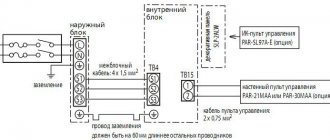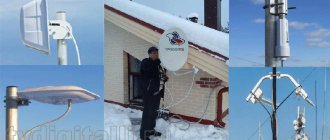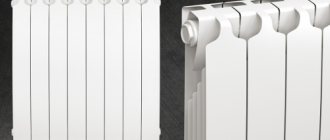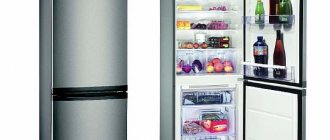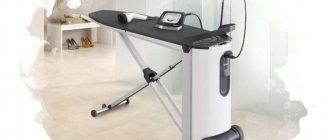Properly choosing boilers for heating a private home is necessary for installing an autonomous system. It is heating equipment that will provide housing with heat and hot water. It will create the microclimate necessary for human habitation. Plus it will work flawlessly. And that's a fact!
Choosing a boiler for heating a private home is not easy
How to choose a boiler for your home
When choosing a heating boiler, several factors must be taken into account. The first is which type of fuel is most affordable in your region. This means not only the price, but also the availability of this type of fuel in warehouses or the possibility of its production/purchase without any problems.
The second thing you need to pay attention to is the possibility of autonomous operation. If there is always someone in the house, this item can be omitted. But if during the work week everyone is at work or school, then it is better if the boiler for heating a private house can operate for a long time without human intervention.
The third factor is ease of use and maintenance requirements. Not everyone and not always want to regularly visit the heating boiler. In this case, it is better to take the most automated version. Yes, they are more expensive, but they require minimal maintenance. As for maintenance - some types of fuel require regular cleaning - combustion chambers or burners. If you are not happy with this aspect, you should choose a boiler that requires minimal maintenance. These, by the way, are units that run on gas and electricity.
Types of existing boilers
There are various types of boilers on the market for heating a private home. They are classified according to the type of fuel consumed:
- solid fuel;
- gas;
- electric boilers;
- liquid fuel.
To this day, the best heating boiler in terms of price for heating in a private home remains a solid fuel boiler. A gas boiler is universal. It is a little more expensive, but does not require constant intervention in the work. An economical option can also be arranged with an electric boiler, having affordable electricity prices or an affordable night tariff. Let's discuss each option in detail. After all, we are interested not only in this factor.
If there is gas
If there is a gas main near the house, it makes sense to consider purchasing a gas boiler. At the moment, in most regions, gas heating is the cheapest. At the same time, gas heating boilers are autonomous - you can not approach them for weeks, and practically do not require preventive maintenance. The only drawback of this solution is the considerable amount it costs to connect to the highway.
Gas is called the country's blue gold
Types of gas boilers
Depending on the type of location, gas heating boilers can be wall-mounted or floor-mounted. The maximum power of wall-mounted options is 60 kW; floor-standing units are also available with 100 kW or more. In addition, some models can work in cascade. What are the benefits of wall-mounted gas boilers? Because they can be installed in the kitchen, especially since their design matches the kitchen design.
Wall-mounted boilers can be installed in kitchens
A separate room is required for installation of a gas floor-standing boiler with a power of more than 60 kW. This can be a dedicated room in the house or an extension with a separate entrance - a boiler room.
Floor-standing require a separate room
You can install a gas boiler even if there is no mains, but it is possible to buy liquefied gas. In this option, a floor-standing gas boiler is installed with a burner that can work with liquefied gas (usually reconfiguration is required). It’s difficult to say right away about the efficiency of such heating: you have to calculate how much 1 kW of heat costs when using the available fuel options. Draw conclusions based on the calculation results.
Gas may be in cylinders
Types of burners
Two types of burners can be installed in wall-mounted gas boilers - atmospheric (open) and turbocharged (closed). Atmospheric burners require a chimney with good draft; turbocharged burners are connected to a coaxial chimney, which can be led directly through the wall near the boiler.
These combustion chambers also differ in the way they select air for combustion. In open burners, air is taken from the room, therefore such rooms must be equipped with supply ventilation of sufficient power. In closed combustion chambers, oxygen is supplied through one of the pipes of the coaxial chimney. Therefore, there are no special requirements for ventilation. But turbocharged boilers have their drawbacks: a chimney installed in the wall can become overgrown with frost, covered with snow, etc. In this case, the boiler does not turn on.
The main difference between wall-mounted gas boilers is the type of burner
When choosing a gas boiler, you should also pay attention to the number of positions in which the gas burner can operate. There are three modifications:
- Single stage. There are only two operating modes - full power and off. The cheapest burners, but the gas consumption is the highest, that is, such boilers are uneconomical to operate.
- Two-stage. There are two operating modes - 100% power and 50%. The third position is off. These burners are more economical and make it easier to maintain the desired temperature.
- Modulated. The most expensive, but also the most economical burners. Depending on the need, they can be turned on either at full power or at 10%, and the adjustment is smooth.
It is clear that in the long term, a boiler with a modulating burner is better for heating a private house. They are more expensive to purchase, but more economical during operation.
Condensing gas boilers
Above we discussed traditional gas boilers for heating a private home. They are also called high-temperature, since at the outlet they produce coolant with a temperature of 45-50°C and higher. Such units are ideal for working with radiator heating.
Condensing boilers are distinguished by the fact that they are effective when operating in low temperature mode - with a temperature in the return pipeline no higher than +40°C. In this case, gas is used most economically - due to the condensation of vapors contained in flue gases, more heat is transferred, which leads to a significant reduction in gas consumption.
A condensing gas boiler for heating a private house with heated floors is an ideal option
This feature of condensing boilers makes them ideal for heating a home with warm water floors. This boiler for heating a private house can produce coolant at the outlet at +35°C, then the return temperature will be about +30°C. Due to this, heating will be economical.
But, as usual, there were some drawbacks. The first is that the condensate formed is very caustic. Therefore, the chimney should be installed only from stainless steel, and of high quality. The second disadvantage is that the price of condensing boilers is higher than traditional boilers of the same capacity. This is due to a more complex design and also to the fact that condensate-resistant materials are used.
Ten best models of solid fuel boilers
10+. ZOTA Pellet 100A
This is a pellet-type boiler, which is characterized by a high level of automation of the process, when the device is capable of operating for several days without additional refueling with flammable materials. The design includes a screw fuel supply and an inflatable fan; it is perfect for the harsh Russian climatic conditions. The maximum power of the equipment is 100 kW, the volume of the fuel bunker is 606 liters. Due to the screw feed, absolute protection against overheating is ensured, and it also prevents flame from penetrating into the fuel storage bunker.
The built-in thermostat sends the device into standby mode when the required temperature is reached. The boiler is connected to the electrical network, from which all automation functions; it has automatic ignition. The main parameters are adjusted using the buttons located on the device body. Automation allows you to keep daily fuel consumption under full control, making the boiler’s operation more efficient and economical. Additionally, you can install a GSM module that allows you to remotely regulate the temperature in the system. The unit is able to heat a building up to 800 square meters.
Advantages:
- Screw fuel supply;
- Availability of an electronic control system for all elements;
- High power;
- High efficiency - about 90%.
Flaws:
- The need to connect to the electrical network;
- Considerable weight of the device.
Pellet boiler Zota ZOTA Pellet 100A
ACV TKAN 100
A fully automated device that uses coal, wood chips, firewood, etc. as fuel. It is characterized by a high efficiency - about 93%, fuel consumption is low - from 8 kg per hour when the boiler is set to maximum performance parameters. The boiler is absolutely safe during operation thanks to its fully sealed combustion chamber and forced air supply. The fuel supply mechanism is equipped with a fire damper.
The convective part is equipped with a pneumatic cleaning system; for the convenience of using solid fuel, there are special grates. The maximum heated area is 300 square meters. m. The highest pressure in the heating system is 3 bar. The device is equipped with automatic equipment, powered by electricity, so the boiler needs to be connected to the network, the burner ignites independently. Basic settings are set using a special remote control located on the unit body.
Advantages:
- Not the largest mass of the product;
- High rated power and efficiency;
- Availability of electronic automation, ensuring safe operation and compliance with all set modes;
- Fuel is supplied using a screw mechanism.
Flaws:
- High price.
Long burning boiler ACV TKAN 100
ZOTA Topol M 20
The boiler is highly reliable and has a very attractive design solution. The fuel loading is vertical, an automatic draft regulator is provided, there is a gas burner connected directly to a household gas pipeline or to a cylinder, and there is a reliable heating element.
The maximum heated area is 150 square meters with a ceiling height of 3 meters. In the heating system, the highest pressure is 3 atmospheres, its volume is designed for 54 liters. The housing has good thermal insulation. Under the decorative casing there is a water jacket that prevents the boiler from overheating; it is additionally covered with basalt cardboard, due to which heat loss is minimal. The combustion door is equipped with a lock; one load of fuel burns out within about 12 hours. The boiler must be connected to a natural chimney, since its design does not include a fan.
More: Top 10 best gas convectors
Advantages:
- The burner is economical, due to which fuel consumption is reduced and thermal power is increased;
- Autonomous control;
- Possibility to use several types of solid fuel;
- Significant efficiency indicators - over 90%;
- Reliable assembly;
Flaws:
- Heavy weight.
ZOTA Topol M 20
Teplodar Cooper Praktik 8
The device is intended for placement in residential buildings and other premises, the area of which should be in the range from 40 to 80 square meters. m. The product is universal; accordingly, it can be used in both closed and open heating systems. The method of coolant circulation does not play a special role - the device works stably with both artificial and natural methods. The boiler can be used as an independent source of thermal energy, but it is often installed as an addition to existing systems running on gas, electricity or liquid fuel. The boiler comes with a poker, a thermometer, a rotary valve and a screw. The device is characterized by small overall dimensions - it occupies a minimum amount of space in the room.
If necessary, the design can be improved with the help of an automatic draft regulator. This device allows you to control the combustion intensity, which significantly saves fuel. The product is suitable for any heating systems made even from small-volume polymer pipes, but in this case they must be connected through a special capacitive-type hydraulic separator. The convector casing here is of a perforated type, due to which the room where the boiler is located is additionally heated. The supply pipe is located on the upper surface of the structure; it is able to provide universal connection and protect the system from air entering it. The firebox is inclined, the fuel is evenly distributed in it. The damper-damper is made of cast iron; it can be used to protect the room from spilling smoldering slag and coals.
Advantages:
- Universal products that can operate on any solid fuel;
- Absolutely safe and well thought out design;
- High efficiency and efficiency.
Flaws:
- Requires placement in a separate room;
- The installation is quite complicated - it’s problematic to do it yourself.
Teplodar Cooper Praktik 8
ZOTA Yenisei 12
It has a very deep firebox, so it will be possible to load firewood up to 60 cm long into it. The firebox door is made at a certain angle, so it will be much more convenient to fill the combustion chamber with bulk fuel. The loading and ash doors fit quite tightly to the main body of the boiler, do not let combustion products into the room, and air will not enter the combustion chamber through them. This, in turn, will have a positive effect on cravings. You can control the combustion process with a special air supply damper. There is a thermometer on the side wall of the device that shows the temperature of the water leaving the boiler. If necessary, you can install a mechanical draft regulator, but you will have to purchase it separately - it is not supplied with the boiler.
Electricity can be used as an auxiliary heat source. For this purpose, the boiler is equipped with special stainless steel heaters. The water jacket is located along the entire contour of the boiler, including under the ash pan. Due to this feature of the device, the amount of heat transferred to the coolant increases, and deformation of the ash drawer also does not occur. Advantages:
- Decent efficiency indicator;
- Can work with any solid fuel;
- It is possible to install additional parts;
- High quality workmanship;
- The doors fit tightly to the body.
Flaws:
- Servicing the device is somewhat problematic.
ZOTA Yenisei 12
EVAN WARMOS TT-18
This boiler can be used not only for residential, but also for industrial or agricultural premises. It can be used either as primary or additional heating equipment. The main rule is that it must be located in a room equipped with a natural ventilation system. For higher efficiency, the device is equipped with a flue gas combustion system.
More: Morphy Richards Homebake 502001 bread maker - full review: prices, specifications, reviews
The design has a heating element and a reliable draft adjustment system. The main function of the heating element is to maintain the water temperature to prevent the heating system from defrosting. The unit operates on the basis of natural circulation of water due to temperature differences, however, the pipes will need to be positioned in such a way that the coolant can pass through the system independently. If it cannot be ensured, then you will have to additionally install a circulation pump and an expansion tank that has direct contact with atmospheric air. The maximum pressure at which this boiler can operate is 5 bar. The unit is designed for an area of up to 120 square meters.
Advantages:
- Easy to install;
- Reliable build quality;
- Possibility of using any solid fuel.
Flaws:
- The position of the damper must be adjusted manually to prevent excessive fuel consumption;
- Rapid fuel burnout.
EVAN WARMOS TT-18
Lemax Forward-16
It is a fairly simple device with nothing superfluous. The design is very reliable, does not require maintenance, and has a reasonable price. The body is made of decorative metal panels. Behind it lies a layer of thermal insulation, under which there is a housing made of low-carbon steel 4 mm thick. The fuel chamber is large and is protected from overheating by a water jacket.
To increase the strength of the equipment, the heat exchanger is reinforced with a channel, making the likelihood of rupture low. At the bottom of the device there is a heat-resistant grate; under it there is a box for slag and ash. It can be removed through the door on the front panel; it also acts as a damper that regulates the amount of air entering the combustion chamber from the room. The pipes through which the supply and return lines of the heating system are connected are located on the rear panel. There is also a chimney pipe with a damper that regulates draft. The boiler can operate on wood or brown coal; for convenience, there is a top fuel loading system.
Advantages:
- Possibility of using any type of solid fuel - coal, coke, firewood, and so on;
- Small overall dimensions, no need for constant maintenance;
- Convenient top or end loading;
- Low cost.
Flaws:
- Low efficiency;
- The need to regularly load fuel, as it burns out quite quickly.
Solid fuel boiler Lemax Forward-16
Kentatsu ELEGANT-03
The device is a very durable and reliable product, which is intended for heating rooms for various purposes. The control here is simple mechanical; there is no need to connect it to the electrical network. The device is capable of operating on coal and wood; it has a fairly durable heat exchanger made of cast iron and can withstand severe physical stress, including high pressure of the coolant itself. The grates here are cooled, and the overall productivity is high. The device is manufactured on the basis of a multi-section heat exchanger, which is produced using the new AminGas technology. It is resistant to corrosion processes and has good resistance to temperature loads. The fuel is burned completely due to the supply of secondary air. The boiler is single-circuit, but it can also be adapted to supply hot water - for this you will need to purchase indirect heating boilers. They are connected to the heating circuit, take part of the heat from there and direct this energy to spiral heat exchangers.
The combustion chamber is spacious, the loading door is also quite large, so adding fuel is easy. The temperature of the heating circuit can be adjusted using mechanical draft control. The highest temperature of the coolant can be 90 degrees, the pressure should not exceed 4 bar. The boiler can be used in closed systems equipped with forced circulation.
Advantages:
- Quite reasonable cost;
- High performance;
- Acceptable dimensions;
- Universal device;
- Good manufacturing and assembly quality of the device;
- Long service life;
- There is no need to connect the product to power supply.
Flaws:
- The ash tray is not very conveniently located - getting it out is problematic.
Kentatsu ELEGANT-03
3. Teplodar Cooper OK 15
In the top solid fuel boilers, this unit is in an honorable third place, largely due to the long burning of the fuel. So, on one stack of firewood, the equipment can work for about 30 hours, briquettes burn out in two days, coal about 5 days. Perfect for residential, warehouse and even industrial premises, the area of which does not exceed 150 square meters.
Also: Should you choose a steam cooking system or a multicooker?
Both water and antifreeze can be used as a coolant; any solid fuel - briquettes, firewood, coal - can be used as fuel. When installing additional elements, the boiler will operate on electricity or gas. The heat exchanger is made of 12 tubes, which ensures high efficiency of the device. The door is sealed, due to which smoke will not pass into the room, and the fuel will burn much longer due to poor access of oxygen to the firebox - it is made on the basis of the state standard GOST 9817-95.
Advantages:
- High build quality of the device;
- Economical operation with significant efficiency;
- Excellent value for money.
Flaws:
- Significant mass, which makes it difficult to move the boiler from one place to another.
Cooper boiler. Reviews.
Teplodar Kupper OK 15
Solid fuel boiler Nedelka “KO-90”
Heats rooms of 150 - 400 sq.m.
An ideal option for a private home, cottage, car service center, as well as a car wash. On one load of 300 liters it can work for up to 7 days. Operating power: 15−45 kW (adjustable using automation). Peak power: 90 kW
You can buy Nedelka boilers here.
Advantages:
- Mass production;
- Made of Russian steel 5 mm grade 09G2S produced by MMK;
- The hatch for cleaning the heat exchanger can be located either on the left or on the right;
- All stages of production are controlled;
- Insured liability to the consumer in ROSGOSSTRAKH in the amount of 10 million rubles;
- Patented production technology;
- Availability of documentation confirming fire safety and reliability of use.
Flaws:
- Weight and dimensions, but this makes the boiler reliable, with good one-time loading;
- The presence of condensation may seem like a minus, but it is an indicator of the high efficiency of the boiler, and there are effective ways to reduce it;
- Energy dependence. Undoubtedly a minus, but easily corrected, when solving it the house always becomes warm, regardless of whether there is electricity or not.
Boilers Nedelka - company presentation
Stropuva Mini S8
The leader of our review of the best solid fuel boilers is capable of high-quality heating of a room whose area reaches 80 square meters. m. Coal, firewood, wood briquettes, and so on can be used as fuel. The burning time for one load of fuel is significant: ordinary firewood burns out in about 30 hours, briquettes in 48 hours. These are the maximum parameters that can be affected by the heat loss of the building, external air temperature, and fuel quality. The overall dimensions are not too large, the boiler takes up a minimum of free space. The design is not too complicated - the device consists of two cylinders placed one inside the other and made of steel. There is a layer of external thermal insulation, so you won’t be able to get burned on the walls of the boiler. The coolant passes through the space between these cylinders. Inside the smaller of them there is a combustion chamber, which is served through doors on the body of the device.
The combustion process itself occurs only in the upper layer of fuel. Heated air from a special chamber is directed here through a telescopic tube. When the top layer of fuel burns, the tube moves to the bottom layer and so on. This design solution allows you to increase the efficiency of the device, as well as adjust the temperature of the coolant depending on the needs of the user. Before entering the chimney, combustion products first flow around the air heating chamber, transferring their heat to it.
Advantages:
- Absolute energy independence of the product;
- Reliable and safe design;
- Can heat a large area;
- Uses fuel economically.
Flaws:
- Except for the rather high cost not found.
solid fuel boiler Stropuva Mini S8
On electricity
If it is technically possible (a significant amount of kilowatts have been allocated), you can install an electric boiler for heating a private home. In terms of ease of operation, these are better units. If there is electricity, they operate in the specified mode, are almost silent, and do not require maintenance. Their main disadvantage is the large sums that have to be paid for heating.
Not only 220 V, but also 380 V can be used for heating
Types of electric boilers
Today there are three types of electric boilers for heating a private home:
- On heating elements. The most common and familiar type of electric boilers. Units that can operate in several power modes (multistage) are more economical to operate. Disadvantages - rather low efficiency - due to heating losses of the heating elements themselves. The advantage is simple repairs and relatively inexpensive consumables (heating elements). This is what an electric boiler looks like on heating elements
- Induction. These boilers use the release of heat when electromagnetic induction occurs. In such electric boilers, water is heated when passing through an inductive coil. Sellers (and even owners of such boilers) say that such installations are more economical than heating elements - there are no losses for heating the heating elements, and there is practically no inertia. The advantages of such boilers include their small size. They are a small piece of pipe - from 35 cm to something over a meter long (depending on the power). The disadvantage of such equipment is that in the absence of coolant flow, the induction boiler very quickly overheats and burns out. Electrode and induction boilers look approximately the same (this is electrode)
- Electrode. This type of boiler for heating a private home is the least popular, although it is also positioned as more economical. The whole point is that an electrolyte - water with certain electrical characteristics - must circulate in the pipes. This is necessary because the coolant heats up due to the release of heat when current passes between the two electrodes. The device is simple, but requires monitoring the condition of the coolant and electrodes. The fact that the heating system is actually energized does not add to its popularity.
In general, if you are thinking of installing an electric boiler for heating a private home, choose between a traditional heating element or an induction one.
A way to make heating cheaper
If there are multi-zone tariffs in the region and an installed two-tariff electric meter, using an electric boiler for heating a home can be made less expensive. To do this, install a large-capacity heat accumulator in the system. The water in it is heated during the nightly, lower tariff. During the day, during the expensive tariff, the boiler is turned off and the temperature is maintained by transferring the heat stored in the heat accumulator.
If you have a two-tariff meter, you can install a heat accumulator (TA) to save money
What to consider when choosing a heating boiler?
Purpose. Heating equipment is required both in industry and in everyday life, so when choosing, it is important to consider for which room this or that model is suitable. Thus, any equipment for a wooden house is subject to increased fire safety requirements; for a modern cottage, it is important to have automated, “smart” functions. Those who install a heater in an apartment in an apartment building are primarily interested in the efficiency and compactness of the device. And boilers for industrial needs must be reliable and at the same time productive.
Type of fuel. This criterion determines which raw materials are used to generate heat. Models running on gas, electricity, diesel fuel, wood and coal are common. Each type of device has strengths and weaknesses. For example, gas boilers are practical and low cost. At the same time, such models need to be connected to a gas main, and during their installation it is necessary to create a chimney. Electric boilers are compact and environmentally friendly, but they are inferior in efficiency to their counterparts. Solid and liquid fuel boilers are more unpretentious and are able to work where there is no access to gas and electricity.
Accommodation option. Boilers can be placed on the floor or on the wall. Wall-mounted units are lightweight, compact, and equipped with all the necessary elements. Their main disadvantage is the copper heat exchanger, which limits power. Floor-standing boilers, on the contrary, are equipped with a cast iron heat exchanger, which makes them more durable, but increases the overall dimensions and weight of the equipment.
Power. This parameter depends on the area of the heated room and the height of the ceilings in it. To heat water in parallel with heating, more powerful boilers are needed.
Number of circuits. There are single-circuit and double-circuit boilers, the latter providing not only heating for the house, but also hot water supply to the home. Such units combine the solution of two problems at once, saving money.
Solid fuel boilers
Despite all the shortcomings, solid fuel boilers are used in most cases for heating a private home. Probably, this is largely due to habit and tradition, but the fact remains that more solid fuel boilers are installed in our country than all others.
Solid fuel boilers operate mainly on wood and coal
Basically, two types of solid fuel are used for heating - wood and coal. Whatever is easier to get and cheaper to buy is what is mostly heated. And boilers for coal and firewood must be used differently: in wood-burning solid fuel boilers, the loading chamber is made of a larger volume so that more firewood can be stored. In coal TT boilers, the firebox is made smaller in size, but with thicker walls: the combustion temperature is very high.
Advantages and disadvantages
The advantages of these units include:
- Inexpensive (relatively) heating.
- Simple and reliable boiler design.
- There are non-volatile models that work without electricity.
Serious disadvantages:
- Cyclic operating mode. The house is sometimes hot and sometimes cold. To level out this drawback, a heat accumulator is installed in the system - a large container with water. It stores heat during the active combustion phase, and then, when the fuel load burns out, the stored heat is used to maintain normal temperature.
- The need for regular maintenance. Firewood and coal must be laid, ignited, and then the intensity of combustion must be adjusted. After burning out, the firebox must be cleaned and the process started again. It's very troublesome. The operating principle of a conventional solid fuel boiler
- Inability to leave home for a long time. Due to the cyclical nature of the work, human presence is necessary: fuel must be added, otherwise the system may freeze if left idle for a long time.
- The process of fueling and cleaning the boiler is quite a dirty task. When choosing an installation location, this should be taken into account: the boiler should be installed as close to the front door as possible, so as not to carry dirt through the entire room.
Generally speaking, using a solid fuel boiler to heat a private home is an inconvenient solution. Although the purchase of fuel, as a rule, is relatively inexpensive, but if
Selecting a solid fuel boiler
Heating boilers with automatic fuel supply. Pellet (granulated pressed sawdust) and coal boilers with automated fuel supply can operate independently for no more than a week. Autonomy depends on the size of the raw material bunker. These boilers rarely need to clean the valves.
Heating boilers with manual fuel loading, depending on the design, can be divided into 3 subgroups:
- Traditional solid fuel boilers. The least convenient of all of these is a wood-burning boiler. In its classic version, raw materials must be fed into a wood-burning boiler every 4-6 hours. Which in itself is already quite labor-intensive.
- Pyrolysis boilers have two fireboxes. In one, the process of smoldering of the bookmark occurs with minimal air supply. Subsequently, the products of incomplete combustion enter the second furnace, where they burn out completely, with a more efficient air flow. Based on this technology, regardless of the power of the boiler, the fuel always burns completely, and accordingly the boiler has maximum efficiency and does not require frequent additions of raw materials. Top combustion pyrolysis boilers are designed differently. The peculiarity lies in the method of laying raw materials. The fuel is located in the lower bunker, and the combustion process is located above them and, thanks to a movable telescopic pipe, the combustion zone moves down until the fuel runs out.
- Long burning boilers . A striking example of such a boiler is the Stropuva and its modern analogues proposed back in the Soviet Union. The boiler has a complex piping system. Connecting such a system is very expensive and not everyone can cope with this task. But such a boiler needs to be serviced with briquettes only once every three days, and when burning coal it is necessary to add fuel only once every 4-7 times.
Long-burning heating boilers for the home can be divided into cast iron and steel. Steel ones are the most popular due to their greater availability in terms of price. At the same time, they are less durable in terms of operation. Cast iron boilers are much more expensive in price, but they also last longer. Typically, cast iron boilers have a smaller loading chamber and burn accordingly less. They also require more frequent cleaning of the heat exchanger. Everything sticks to cast iron more thoroughly.
There are also bunker boilers. They don't require attention the most. Such a boiler can burn without human intervention for several days. But such a colossus is expensive.
Which solid fuel boiler can be awarded the title of best? Which one should you choose? Here we would approach from a position of practicality. And we would boldly highlight long-burning steel boilers . They are universal in price, do not require special attention and will serve their owner for 10-15 years of active work without any problems.
Good examples of such boilers include Buderus Logamax S-111, Zota Carbon.
Liquid fuel
Heating boilers for private homes using liquid fuel are the least common. There are too many disadvantages to this type of heating:
- Fuel is expensive.
- It needs to be stored somewhere, and this is a large container that needs to be installed somewhere not very far from the house so that fuel can be supplied to the boiler.
- For normal heating operation, it is necessary to heat the storage tank, since at low temperatures heating oil thickens and clogs the burner.
- During operation, the burner makes noise and smells, so such equipment requires either a separate boiler room or an extension, but with good sound insulation and ventilation.
Storage of liquid fuel requires a large tank
In general, it makes sense to install an oil-fuel boiler for heating a private home if you have a free (or almost) source of fuel. In all other options, it is better to use other heating equipment.
Liquid fuel devices for home heating
Liquid fuel heating devices usually use diesel fuel, oil or gasoline.
Such a system works completely autonomously, and its characteristics are quite good: the room is heated quickly, and the heat lasts for quite a long time. But liquid fuel heaters have their weaknesses. Firstly, the installation of such a boiler requires a separate room, which will be maximally protected from a possible fire, therefore it is advisable to place liquid fuel heating boilers in brick extensions equipped with an exhaust hood. Secondly, the need for constant refueling suggests that it needs to be stored somewhere - and storing diesel fuel or gasoline is quite dangerous, since these substances can cause serious harm if stored incorrectly.
When choosing a boiler that runs on liquid fuel, you need to think about it in advance and consider alternative heating options, since many of them have a better level of fire safety than liquid fuel devices.
Pellet boilers
Boilers operating on pellets are difficult to classify, so they are usually discussed separately. The fuel for this type of boiler is small pellets made from compressed sawdust. A bunker is made near the boiler to store pellets. Its size determines the battery life of the equipment. If there is enough space, the bunker can be made to hold several tons of fuel. The minimum size is for a couple of buckets, which is enough for a day of work.
Pellet boiler
The pellet heating boiler is equipped with a special burner. Pellets from the bunker are automatically fed into the combustion zone, where they burn with virtually no residue. Normal quality granules produce only 3-5% ash. Therefore, cleaning is rarely required - once a week or even once every few weeks. The equipment is fully automated; with a sufficient supply of fuel, you can go weeks without visiting.
But even here there are some drawbacks. The first is the high price of equipment. The second is the demands on the quality of pellets. They should have low ash content, good calorific value, and should not break or crumble. Otherwise, a pellet boiler for heating a private home is a good choice. Another advantage is that waste from the wood processing industry is used.
Traditional solid fuel boilers
So, heating boilers: what are the nuances and technical aspects that distinguish their types?
These designs are good primarily for their complete autonomy: the operation of conventional solid fuel boilers does not require pumps, fans or control modules, so there is no dependence on external factors. Such boilers can operate on different types of fuel, but there are some conditions that slightly complicate their operation. For example, devices operating on wood or waste from the wood processing industry are completely unable to work with coal, since its combustion temperature is much higher, so its use can lead to very rapid problems with the boiler. Exactly the same principle lies in the impossibility of using pellets, so when choosing a boiler it is necessary to clarify what fuel it runs on.
Most often, solid fuel boilers distribute heat directly, i.e. without the use of pipelines and heating devices. Lithuanian stove models, in which fuel can burn for almost a week, and some domestic models can boast of very good quality. Such stoves are often used for heating industrial buildings. German designs could claim the title of “the best heating boiler,” but their cost scares off many potential customers.
In any case, when choosing a boiler, you need to take into account, first of all, the conditions in which it will have to work, and how convenient it will be financially. Only then will the choice be as justified as possible.
Combination boilers
There is also such a modification of heating boilers as combined heating devices. The most popular option is a solid fuel boiler with several electric heating elements. Such units operate as TT equipment while the wood or coal is burning; when the fire goes out, the boiler cools down slightly, the electrical part turns on. In this case, heating elements are not able to fully heat the house, but they manage to support the system. That is, in the morning the house will not be cold. And in the event of a long absence, the heating elements will not allow the system to freeze.
Several combi boilers
Another popular option is TT combination boilers with liquid fuel burners. Such units have two separate combustion chambers. One for solid fuel, the second for a burner with liquid fuel.
The advantages of such boilers are obvious: you can use several types of fuel. The disadvantage is the high price and average efficiency - the efficiency of each part is not very high. So a combination boiler for heating a private house is a controversial decision.
Heating boilers in the Tavago store
The heating system is one of the most important components of a comfortable life.
It is difficult to imagine life without basic amenities, such as hot water and warmth in the house. And in the Russian climate, living without heating is not at all possible. For the system to operate, a whole range of equipment is required: a pipeline system for circulating coolant, radiators for transferring heat to the room. But the key element is the heating boiler.
In our online store you can select and buy a heating boiler of the desired configuration. The range is represented by both models for home use and industrial devices for heating systems in residential complexes, offices, and retail facilities.
So how do you choose a boiler for heating a private house?
To make it easier to navigate when choosing, let's systematize the information. Let's look at the most typical requirements that influence the choice of boiler type:
- The most economical heating. The cheapest heating options are wood/coal and gas. Next come pellets, liquid fuel and electricity. In general this is true, but the situation greatly depends on the region. In some places electricity will be cheaper, in others liquid fuel will be cheaper. In general, you have to count.
- Degree of autonomy. The most automated are gas, electric and pellet units. They can be left at work unattended. Liquid fuel ones require a little attention. The least automated are solid fuel ones. To keep your home warm, you need to choose the right boiler for heating a private home.
- Difficulty connecting. The most difficult thing is with the registration and connection of gas. There may be problems with allocating power for electric heating - not all substations have a reserve. With the rest, everything is simple: the main thing is to follow the recommendations for safe installation.
If you take into account the availability and affordability of fuel, making your choice is not difficult.
How to organize hot water supply (DHW)?
A double-circuit boiler is considered when there are only a couple of mixers in the house (in the kitchen and in the bathroom), and both are located within a radius of 5 meters. One circuit works for heating, the second for hot water supply. Water is heated using the flow method. Its maximum temperature depends on the flow rate, so when used simultaneously by several consumers - for example, in the kitchen and in the bathroom - differences may be felt. The speed of heating water for domestic hot water depends on the power; the manufacturer indicates the number of liters per minute.
Alternative option : a single-circuit boiler with a boiler - a container that accumulates a supply of hot water for domestic needs using indirect heating. This solution is more expensive, but you get a stable temperature regardless of the flow rate. There are some nuances: it takes some time to reheat the water in the boiler; The boiler requires additional space for installation. Take them into account when choosing the volume.
Pipe materials in the boiler room - what to choose?
How to choose a good gas boiler for heating a private home
Compared to all other varieties, this is the most common. It is convenient and provides excellent room heating when installed correctly. Such units use fuel economically, do not require its preliminary storage and do not require special care. At the same time, the work is automated - the owner does not have to constantly monitor and clean it.
There are floor-mounted and wall-mounted devices - you can save space in the room. They do not create excess dirt and function cleanly.
If you are thinking about how to choose a high-quality heating boiler for a private home, then do not forget that installation will require a permit, which is issued only by a special institution.
Types of gas equipment
All varieties available on the market are divided into 3 main ones:
- Atmospheric. They work with an open combustion chamber and provide an efficiency of up to 90%. Air is supplied in the usual way, and exhaust gases leave through a traditional chimney. The main thing is to install the pipe correctly. Therefore, you should entrust this to professionals and not try to install it yourself.
- Turbocharged. They are also called supercharged. Their combustion compartment is completely closed, and the useful effect is up to 93%. To introduce air there, a fan is required, and smoke escapes through a special hole.
- Condensation. They use the latent heat of combustion of hydrocarbons, so the efficiency does not exceed 96-97%. It resembles the previous version, but the burner and the chamber itself differ in their cylindrical shape.
All types can be equipped with a DHW water circuit. The price also increases from first to last.
Features of condensing boilers
Unlike conventional gas models, this one allows you to use the heat from the fuel as efficiently as possible. In some cases, its efficiency reaches 100% or higher due to its design. This is due to the fact that even the energy that may be released during the condensation process is used.
It is equally important to carefully approach the installation of the chimney, regardless of the type of boiler chosen. If you do not know how to choose the right chimney kit for your boiler, contact FERRUM. We will help you choose the best option and resolve the issue of removing combustion products.
How to choose a boiler
We will assume that we have decided on the type of fuel. Now let's take a closer look at what you need to pay attention to when choosing a boiler.
Single-circuit and double-circuit
Boilers are single-circuit and double-circuit. In simple terms, single-circuit ones simply heat the house, while double-circuit ones also heat the water. In modern single-circuit boilers it is also possible to achieve water heating, but it will be necessary to install a boiler.
Energy dependence
Here, too, everything is simple: whether the boiler needs electricity to operate or not. Typically, electricity is needed for boilers with automation, when various temperature or safety control systems are operating.
For example, solid fuel boilers do not require electricity: the wood simply burns, releasing heat. But gas or electric ones definitely won’t be able to work at all.
Boiler power
It is very important to choose the correct boiler power. If there is not enough of it, then it will be cold in winter. If you take more than you need, you will constantly overpay. It is better to contact specialists to calculate the required power, otherwise there is a risk of not taking something into account.
Modern models also have power adjustment, where you can set the required heating temperature. Thus, it is better to take a boiler of slightly higher power, as a reserve.
The combustion chamber
Boilers that use air to burn fuel are equipped with an open or closed combustion chamber. For open air, the air is taken directly from the room, so a chimney and ventilation are absolutely necessary. For a closed one, air is taken in from outside, so ventilation may not be planned.
Type of placement and dimensions
Everything is simple here: boilers are wall-mounted and floor-mounted. Of course, wall-mounted boilers win in terms of size: they are compact and can be installed in the kitchen.
However, floor-standing boilers, despite their bulkiness, benefit in power. Therefore, for a large private house, of course, it is worth considering a floor-standing boiler.
Safety
It’s worth saying right away that all boilers are safe if installed correctly, following operating rules and regular maintenance. Therefore, it is very important to comply with all the rules and regulations established by the manufacturer and regulatory authorities.
Manufacturer, warranty, service life, weight and cost
There are many different boiler manufacturers on the market: both foreign and Russian. For example, such as Baxi, Proterm, Buderus, Viessmian, Bosh, Vaillant, Navien. The more confident the manufacturer is, the longer the warranty period.
It’s worth taking a closer look at the cost of the boiler. You need to understand that in addition to the price of the boiler itself, you also need to add the cost of its connection, maintenance and the price of fuel. Therefore, it is likely that the cheapest boiler will be the most expensive to operate.
